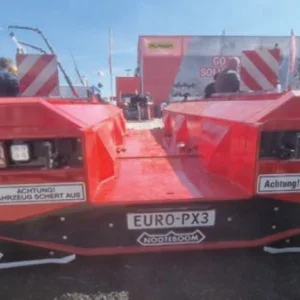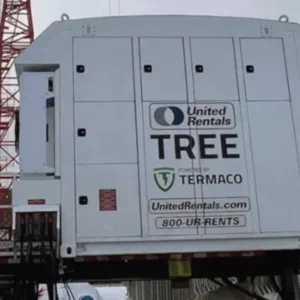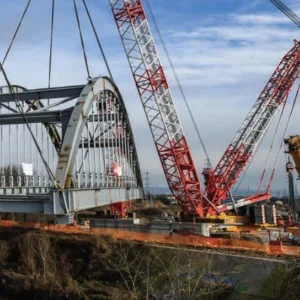It is now just over a year since Terex announced (Cranes Today May 2006 p6) it had acquired a 50% stake in China’s third largest hydraulic crane manufacturer, Sichuan Changjiang Engineering Crane Company (CJ Crane). In making this move Terex also became the first foreign company to acquire management control of a Chinese mobile crane joint venture. Tadano followed suit, increasing its stake in the BQ-Tadano joint venture from 25% to 50% and acquiring management control. At present, a 50% stake is the maximum allowed by Chinese law for foreign investment in a mobile crane company but should the law change Terex has already agreed terms with its Chinese partner allowing it to acquire full ownership.
Terex and Tadano were astute in their selection of partners since CJ Crane and BQ are two of only six Chinese enterprises qualifying as licensed producers of (crane carrier) vehicles. The other four crane carrier producers, XCMG and Zoomlion, the nation’s largest mobile crane producers, and First Auto Works (FAW) and China National Heavy Truck Corporation (CNHTC), both leading automotive manufacturers, are all owned by the Chinese state.
This long-standing Chinese law restricting foreign ownership of certain vehicle producers reflects concerns over national security relating to military vehicle applications. Indeed prior to Terex being allowed to acquire its stake in CJ Crane, certain elements of the original business that manufactured all terrains, telehandlers and other equipment for the Chinese military had to be spun-off.
The fact that only four crane makers are licensed to produce their own crane carrier chassis means that these companies hold a significant advantage over the other dozen smaller Chinese truck crane manufacturers. These smaller companies must purchase ‘generic’ carriers from FAW and CNHTC, which means that neither their crane designs nor their manufacturing costs are optimised.
As a consequence the top three manufacturers control about 80% of the 14,200 mobile telescopic cranes sold by Chinese manufacturers in 2006. The increasing strength of the top three is making life very difficult for many of the smaller manufacturers. One, Jinzhou Heavy Industries, once quite a force in China, recently ceased production.
Focus on Luzhou
According to Terex Cranes president Steve Filipov, the business is performing well: “Last year CJ produced almost 1,500 truck cranes and increased its market share to about 10.5%. This past February we had a record month, shipping 210 cranes. And the business is profitable so we are very pleased with the progress.”
The business has nine board directors, including long-standing president Wang Li and chairman Filipov. “Most of the day-to-day management is conducted at a local level by our Chinese colleagues and with Jean-Marie Coutant as our integration director,” he says. Further help with export strategy comes from Beijing-based Terex Cranes China sales manager Thomas Veith. Chinese crane engineer Lu Yefei has joined the company to help with technology transfer plans.
“We do not plan to simply transfer European or US products to China. For one thing our Chinese products will use components that are almost exclusively locally sourced and there is very limited product support for Chinese hydraulics or drive trains in Europe or America. We see some of our Chinese competitors seeking to develop cranes using the latest European technologies, aimed mainly at competing in overseas markets,” Filipov says, adding that this is not a Terex goal.
“The main criteria for our Chinese products are that they suit Chinese domestic requirements and can be supported by a rather immature domestic product support infrastructure. First and foremost we want Chinese customers to be able to keep our cranes running and to meet and exceed their quality expectations. We want to become the Chinese quality leader.
“We are also looking at plugging into the current supply chain available through CJ, this is not a one way street. Terex Cranes can also benefit from the local supply chain with already substantial volumes made by CJ. This is a longer term strategy as we need to build in quality first locally, but it is on our radar screen.”
In the short term, there are smaller goals, Filipov says.
“We’ve done a tremendous amount of housekeeping to make a cleaner and safer operating environment for our team. When we entered into the joint venture there were some hangovers from the previously-structured business and we’ve managed to consolidate manufacturing into fewer buildings to improve quality and reduce material handling. We are moving away from producing our own steel tubing and working in partnership with Eaton’s local operation so as to improve hydraulic system efficiency and eliminate contamination of hydraulic oil. A great deal of our focus is on improving quality to a world class level.”
History
Changjiang was set-up in June 1965 under a Chinese national economic policy that planned to reduce the concentration of manufacturing industries in China’s northeast by transferring some to western China.
Beijing Crane Works, (now Tadano’s partner), was split in two. Some of its production and several hundred of its employees moved to the city of Luzhou in the western province of Sichuan, near the major cities of Chongqing and Chengdu, which developed a military infrastructure during WWII. Changjiang Crane Factory went into production in 1966, with 1,100 employees and CNY11m ($1.3m) of assets. Its first crane was the 5t lattice boom Q 51 mounted on a small, strengthened, two-axle Dong-Feng commercial truck chassis.
CJ’s tradition of larger hydraulic crane development dates back to its birth. In 1970, CJ developed the 16t Q2-16 hydraulic telescopic truck crane for the Chinese military. This came two years after Beijing Crane Works had built China’s first telescopic truck crane. In the same year, CJ developed the 6.5t Q2-6.5 telescopic truck-mounted crane without help from Beijing Crane Works. 1970 also saw the establishment of another transplanted business next door to the CJ crane plant, Changjiang Excavator Works. In 1971 CJ began to step ahead of its domestic rivals and focussed on larger cranes, and in 1976 it produced China’s then largest telescopic crane, a 65t truck crane.
In the 1980s the Chinese recognised the need for foreign technological assistance. In 1983 Changjiang Crane Factory became the first Chinese crane manufacturer to establish a technology transfer licence, with Liebherr Werk Ehingen of West Germany. The agreement covered three Liebherr cranes, the 40t LT 1040 hydraulic truck crane, 80t LT 1080 hydraulic truck crane and 125t LTM 1125 five-axle all terrain. As part of the agreement, Changjiang built a new 25,043 sq m factory and 8,000 sq m test pad as part of a CNY30m investment, and purchased 225 domestic and 27 imported machine tools.
Changjiang Crane Factory built its first Liebherr hydraulic truck cranes in 1984, and in 1986 developed the largest hydraulic crane then produced in China, the 125t QY 125 all terrain, based on the Liebherr LTM 1125. However, German technology was too advanced for China in those days, and led to heavy losses. Despite this, CJ pressed on with its internal development, establishing a hydraulic cylinder production plant in Chengdu that began operations in 1993. ISO 9001 certification was achieved in 1996.
The following year the owners of the business, Luzhou City Municipal Government, decided to merge their two neighbouring machinery makers, Changjiang Crane Factory and Changjiang Excavator Works, another Liebherr licensee. At that time the crane company employed about 3,900 people, making telescopic boom truck cranes from 8t to 100t, as well as other construction, lifting and access plant. The merger proved a disaster and in 1998 production levels dropped by 33%, creating serious financial losses. The businesses split in 2001, and in May 2003 were privatised under MBOs with significant local government interest. The crane business was reformed as the Sichuan Changjiang Engineering Crane Co. Ltd. By this time, Sichuan Changjiang was producing a hydraulic truck crane up to 130t capacity and had become China’s third-ranked producer with a 2003 output of about 920 units valued at approximately CNY450m ($54.5m).
Throughout this turbulence CJ’s engineers continued to develop new models, including the 50t LT 1050, 70t LT 1070, 100t LT 1100 and 25t QYT 25 hydraulic truck cranes. In 2005 Sichuan Changjiang Engineering Crane Co. Ltd., celebrated the production of its 10,000th hydraulic truck crane, and the business was restructured to separate the commercial truck crane business from the military and special products business. In 2006 CJ introduced a 130t capacity all terrain crane. Shortly afterwards, Terex Cranes acquired a 50% shareholding and management control.
The 130-tonne capacity Terex Chiangjiang LT 1130 making a 20-tonne pick at 9-metres radius (22-tons @ 30ft) woth its 49-metre (161ft) five section main boom extended to a length of 31-metres (101ft). Terex Chiangjiang LT 1130 The 25-tonne (28-ton) capacity LT 1025 6×4 truck crane is one of Terex Chiangjiang’s most popular models thanks to its very impressive load chart strengths and 32.3-metre (106ft) four-section fully-sychronised full power boom. Terex Chiangjiang LT 1025 Mr Wang Li, President of Terex Chiangjiang Cranes standing in front of a ten-year old 12-tonne capacity Chiangjiang QY 12 truck crane working for a local crane rental company in Luzhou on a local hotel landscaping project overlooking the Yangtze River (thWang Li QY 12 The first Terex-Changjiang crane to be painted in Terex colour and the first to be exported in Terex colours -a 55-tonne 960-ton) capacity LT 1055 twin-engined 8 x 4 truck crane equipped with a five section 41m (135ft) five section full power boom – readyCJ in Terex colours Steve Filipov, Terex Cranes president and Terex Changjiang chairman standing before a line of Terex Changjiang truck cranes in the shipping bay at the plant in Luzhou. Filipov T-CJ cranes






